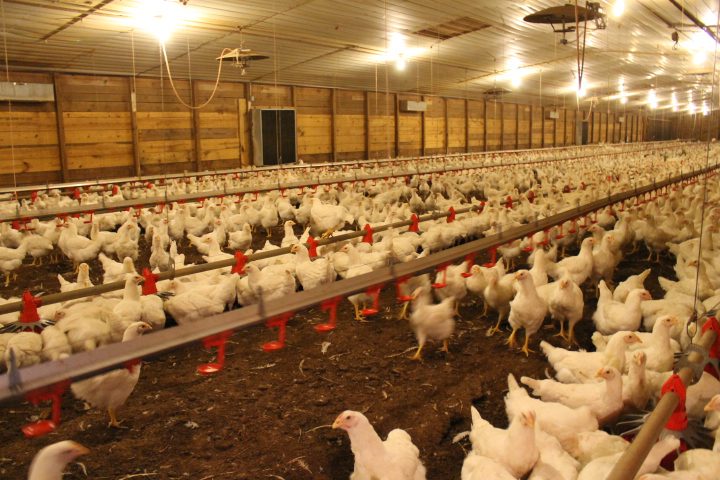Farm Management

The day-to-day work on a commercial poultry farm varies depending on the type of farm: pullet, breeder, or broiler. Growers should understand the level of poultry care, management, and biosecurity measures required for the birds they are managing. Learn more in this second of a five-part series for new farmers in the commercial broiler industry.
For each type of commercial poultry farm, contract growers work under a management protocol from the integrator. Farmers considering commercial poultry should have a basic understanding of the daily requirements for each farm type to know which might best fit their goals. Growers should contact a local integrator to discuss options and talk to multiple current growers in the area before making a final decision.
The integrator owns the birds, provides the feed, veterinary services, and management supervision. The grower owns the grow-out facilities
and is responsible for day-to-day labor and bird care. All growers are encouraged to stay in contact with their field technicians for guidance and assistance. This document is not meant to take the place of any integrator’s management protocols or recommendations, or to cover all the intricacies of daily poultry farm management.
Husbandry Basics
Pullet Farms
Pullet farms are perhaps the most unique of the three farm types. Since pullets and cockerels are the foundation of the broiler program at any complex, these farms are expected to be among the most closely monitored and tightly managed. Pullet growers operate under strict guidelines from the integrator and work closely with integrator field technicians to help ensure that the best breeding stock is grown.
Pullet Management
Both pullet farms and broiler farms receive birds that are newly hatched. The brood phase is the first 10 to 14 days of the bird’s life. This is roughly comparable to a nursery phase in the swine or the calf phase in cattle, where the grower is responsible for the animal’s early development.
The brooding phase is critical as it plays a large part in final flock uniformity and, ultimately, hen production. Mistakes made in the pullet brooding phase can negatively impact production in every grow out sector. Pullet growers must exert extra effort during this vital time.
Feed management is a high priority for pullet growers. Because of the natural dominance hierarchy, or pecking order, that birds quickly develop, some may get more feed than others, resulting in size variations in the flock, if feeding is not managed properly. Special feeding systems and computerized controls are often used to ensure each bird gets the appropriate amount. Pullet growers must maintain these systems to ensure that they deliver feed as expected.
Feed programs often call for periods when feed is restricted entirely. As birds age on a pullet farm, many integrators begin an alternating feed schedule, where birds are fed every other day. This can make the birds more responsive to stimuli in the house. Therefore, care must be taken when anyone is in the house, and unnecessary contact is discouraged during these times.
Pullet farms typically do not deal with high mortality rates, but daily mortality management is required.
Pullet growers typically can expect to raise two flocks per year. Birds stay on the farm for 20 to 22 weeks each cycle. This is followed by a few weeks between flocks to make repairs and prepare the houses for the next flock.
Pullet Houses
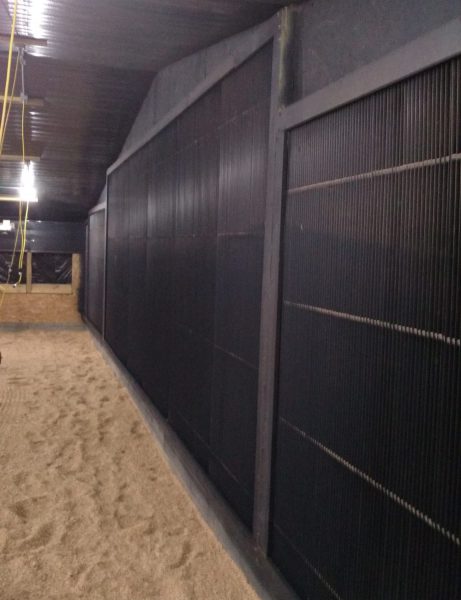
Example of a dark-out “false-wall.” Behind this wall, unseen to the right, are exhaust fans pulling air through it to ventilate the house. The false wall keeps light from entering the house when the fans are operating. Similar components are on every air inlet and exhaust fan in a dark-out pullet house and all must be kept clean and maintained.
Pullet houses are commonly called dark-out houses because of the extreme measures taken to control the birds’ exposure to light. This includes hours in total darkness. These measures are required to regulate growth and sexual maturation. Dark-out houses require constant maintenance to keep all components operating correctly and to control light sufficiently.
Ventilation is always a priority in any enclosed animal- rearing facility. The grower is responsible for 100 percent of the birds’ ventilation needs in the modern poultry house. This is accomplished through various means of exhaust fans and ventilation inlets.
Because of the nature of dark-out components, or light traps, on a pullet house, these houses can be more challenging to ventilate. Since fewer birds are in a pullet house compared to a broiler house, fewer ventilation fans and inlets are typically needed. Even so, maintaining proper ventilation is a daily task that must be coupled with regular dark-out component cleaning and maintenance.
Breeder Farms
Breeder farms are the first true production stage of the broiler industry. Breeder growers receive the hens and roosters from the pullet farms and manage them to produce hatching eggs. The integrator then hatches these eggs to become broilers in the next stage.
Breeder farms are easily the most labor-intensive stage of live production. Breeder hens and roosters are subject to strict feed and water management to regulate the weight of the birds to ensure the best egg production. Breeder growers work closely with integrator field technicians to accomplish this goal.
Management at this stage impacts the stages of production that follow. Mistakes in ventilation, temperature control, and feed/water management can negatively affect fertility, egg numbers, egg quality, and the resulting hatch and chick quality. The downstream impact can be huge since a typical breeder farm produces 1.2 to 1.4 million eggs per house per year. Therefore, breeder growers are guided closely by company field technicians and veterinary staff throughout a flock.
Breeder Houses
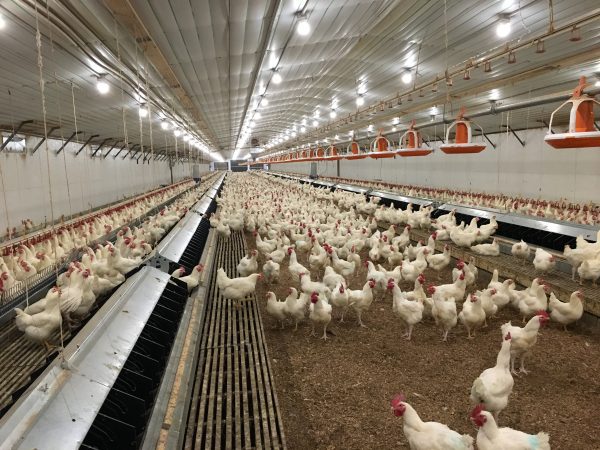 Breeder houses are built like pullet and broiler houses on the outside but with significant differences on the inside. They are specifically designed to accommodate the reproductive activity of the hens and roosters and the collection of fertile eggs.
Breeder houses are built like pullet and broiler houses on the outside but with significant differences on the inside. They are specifically designed to accommodate the reproductive activity of the hens and roosters and the collection of fertile eggs.
These houses have nesting boxes for the hens and specialized hen and rooster feeding and watering equipment. The nest boxes and hen feeding and watering equipment are typically located on raised slat areas on either side of a lowered scratch area where the rooster feeder and waterers are located. Some newer floor-level systems are moving away from raised-slat areas.
Egg collection areas are located outside of the bird area at the ends of the houses. Eggs must be collected, examined, and stored daily, often multiple times a day, and taken to the egg cooler rooms to await pickup.
Fully mature breeder birds produce a lot of body heat; therefore, these houses typically are not heated. Because of the additional heat produced by the birds, breeder houses often have more ventilation fans and cooling equipment to be maintained than pullet houses. There is also maintenance of hen nests, egg collection equipment, and egg coolers to be considered.
Breeder farms typically house one flock of hens per year, with a flock in-house for approximately 45 weeks. Farms then have several weeks to prepare for the next flock. The time between breeder flocks is also labor intensive, as 45 weeks of litter accumulation must be removed. This requires removing the slats and, in some cases, the nests. The houses must be cleaned, all equipment repaired as needed, slats reinstalled, and scratch areas reconditioned before the next flock arrives.
Breeder Management
Getting a newly arrived flock settled into their new home can be challenging for breeder growers. The hens must get used to the slats, nests, and unfamiliar feeder or drinker system, and the roosters must find the hens. This settling-in period can last for a few weeks before hens begin laying eggs of sufficient quality and quantity to be gathered.
Daily management has a measurable effect on total egg production. Growers must work to ensure that eggs are laid in the nest boxes for automated gathering. Combatting floor-laid eggs can be a major task, but efforts by the grower during the early stages of a flock can pay off later in increased production. This is important since growers are paid on a per-dozen basis for hatching eggs.
Once the birds are laying well, eggs are transported from the breeder farm to the hatchery regularly by the integrator. There they are incubated, hatched, and then hauled to a broiler farm for rearing to the desired target weight.
Egg collection, daily ventilation, mortality management, strict feed management, and increased equipment maintenance requirements account for the higher labor needs of breeder houses.
Broiler Farms
Unlike pullet or breeder farms, broiler farms grow several flocks per year. Farms with large birds (7 pounds or more) grow four or five flocks, while farms of small birds (4 pounds or less) may grow as many as seven or eight. The different bird sizes are dictated by their intended market. Larger birds are typically processed into value-added products, such as chicken fingers or breast patties. Mid-sized birds are often sold as grocery store retail cuts, such as packaged boneless breasts or rotisserie whole birds. Smaller birds are often sold as fast-food cut-up pieces.
More flocks mean more new flock preparations, brooding periods, and catch times. Heavier birds mean dealing with heavier mortality for longer periods. All these are labor intensive for the broiler grower, and hired labor is often employed to help during these times.
Broiler growers work under the supervision of company field technicians. However, they generally have the least direct supervision since there are far more broiler farms than pullet or breeder farms in a complex. This partly explains the competitive pay system under which most broiler growers operate. For more info on broiler pay, see Alabama Extension publication ANR-2932, “New Farmer’s Guide to the Commercial Broiler Industry: Basic Farm Types and Their Estimated Business Return.”
Because the broiler farm is the final stage before processing for consumers, birds are closely monitored for health issues to ensure a wholesome product. Since the broiler grower doesn’t have constant supervision of company staff, they must pay close attention to bird health and communicate back to company personnel and veterinary staff quickly if they detect any bird health issues.
Broiler Houses
Broiler houses are the most densely stocked poultry house of the three types. It is common for there to be less than one square foot allocated per individual bird at the final weight. A modern 60 × 600-foot broiler house may grow 36,000 to 52,000 chickens. Larger target- weight birds need more space to access feed and water adequately; therefore, houses growing those birds have fewer chickens. Houses for smaller birds contain more chickens per house.
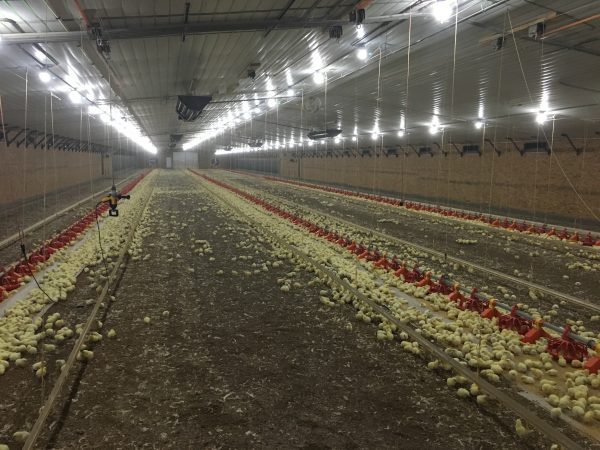
Brooding is an important stage for both pullet and broiler growers.
Broiler houses have most of every kind of equipment in a modern chicken facility simply because they house the most chickens. There are tremendous numbers of feeders, drinkers, heaters, fans, air inlets, cooling equipment, and computerized control mechanisms that must be kept in top- performing condition. The houses must be able to provide a day-old chick the heat needed for proper brooding as well as swiftly transition to cooling a growing bird producing large amounts of body heat. They must do this year-round, regardless of outside weather.
Even though most systems are automated, growers must still be vigilant to make basic changes daily if they expect to keep pace with the growing birds. Daily adjustments to feeders and drinkers are required. Environmental conditions of the houses must also be monitored to ensure that ventilation systems and computer programs that control them are accomplishing the desired results.
After a flock leaves, the houses must have the litter prepared for the next flock. This often means removing wet litter, reconditioning the remaining litter, or adding additional new litter material. Between-flock litter management is one of the most important but often overlooked aspects of successful broiler production. It requires growers to have and maintain their own litter handling equipment or hire someone with the equipment to perform the job.
Broiler Management
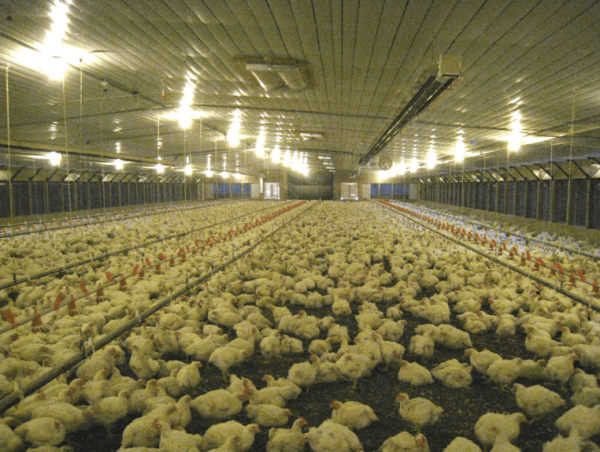
A modern house with market-aged broilers needs constant ventilation to keep the birds comfortable.
The broiler grower has possibly the highest stress farm to manage simply because of the speed at which the entire process takes place. Large 9-pound birds may take 70 days to reach market weight and small 3.5-pound birds can reach market weight in as little as 32 days. This has allowed chicken to become the least expensive animal protein available and the most sustainable, requiring the least amount of feed and energy inputs per pound of all animal proteins.
This turnaround speed and efficiency require tight management and close attention to detail inside the poultry house. Even a brief time of substandard conditions can cause serious issues. Mistakes are measured by the hour, not the day. Larger mistakes can easily mean the death of thousands of birds.
Mortality removal is a daily management responsibility. Since there are many more birds per house, mortality removal is a bigger job on broiler farms than on the other two farm types. As birds get larger, especially in times of disease outbreaks, this can become a serious undertaking. Mortality disposal is the full responsibility of the grower. There are several disposal methods to consider, and each requires a certain amount of expense, labor, and management to meet all environmental regulations and biosecurity standards. For more information, see Extension publication ANR-2921, “Mortality Disposal Methods for Commercial Growers,” available at www.aces.edu
Biosecurity Concerns
Biosecurity, or the protection of birds from diseases, as well as the protection of human caretakers from zoonotic threats, is a primary focus of the commercial poultry industry. While the close confinement of birds protects them from the elements and predators, it also can enable the fast spread of contagious diseases and viruses inside houses.
Commercial poultry companies vaccinate birds for many disease threats. There is always a possibility, however, that an existing wild strain of an avian virus, such as avian influenza, could find its way into a poultry house, causing serious sickness or death of the birds. That’s why it is so important for growers of all sectors of live production to practice strict biosecurity on their farms.
A disease outbreak could cause a grower to lose significant portions of a flock and seriously damage their livelihood. In areas of the country where poultry farm density is high, a large outbreak of a contagious virus could have severe negative impacts on the entire area’s economy. These concerns make biosecurity a primary focus.
All poultry companies have biosecurity protocols that growers must follow to protect the birds on the farm and prevent spreading of disease to other farms in case of an infection. Historically, many disease outbreaks have been tracked back to lax biosecurity of an issue that was not considered serious at the time.
Biosecurity is an integral part of everyday life, on and off the farm. This means taking simple actions, such as dedicating clothing and shoes to wear only in the poultry houses, building biosecure entrances into the houses and farms, and maintaining strict control over who enters the farm and houses.
Biosecurity is still important even if a farm is not located in a poultry-dense area. Ducks, geese, and other wild fowl carry many diseases detrimental to domestic chickens. Rodent and insect control are also parts of a biosecurity plan since they also carry detrimental diseases.
Biosecurity Resources
- “Poultry Biosecurity Measures Imperative During Current Avian Influenza Outbreaks” on the Alabama Extension website at www.aces.edu
- “Avian Influenza FAQ:June 2022 Update” on the Alabama Extension website at www.aces.edu
- “Biosecurity for Backyard Poultry Flocks” on the Alabama Extension website at www.aces.edu
Definition of Terms
- Breeder farm. Grower-owned housing for producing hatching eggs to be hatched for broilers.
- Broiler. Chicken grown to a specified weight for meat production.
- Broiler farm. Grower-owned housing for broiler grow out.
- Complex. All business entities needed to support a local poultry processing plant, such as hatchery, feed mill, transportation, etc. Includes all grower-owned live production facilities. Sometimes called business units or grow-out units.
- Dark-out houses/components. Light-trapping components installed on fan and ventilation inlets of pullet houses to limit (down to zero) the amount of light allowed in the house through openings.
- Hen (breeder hen). Mature female chicken producing hatching eggs (sometimes referred to as “layers”).
- Integrator. Major poultry-producing company (e.g., Tyson Foods, Pilgrim’s, Koch Foods). These companies own the birds, supply the feed, and are responsible for all aspects of transporting, processing, and marketing the birds.
- Pullet. Young or sexually immature female chicken.
- Pullet farm. Grower-owned housing for raising breeder hens and roosters from chicks to sexual maturity.
- Rooster. Mature male chicken.
- Slats. Components making up the raised areas on each side of a breeder house. Slat areas are where the hen feeder, drinking system, and nests are located.
Back to New Farmer’s Guide to the Commercial Broiler Industry
 Dennis Brothers, Associate Extension Professor, Agricultural Economics and Rural Sociology, Auburn University
Dennis Brothers, Associate Extension Professor, Agricultural Economics and Rural Sociology, Auburn University
New October 2022, New Farmer’s Guide to the Commercial Broiler Industry: Poultry Husbandry & Biosecurity Basics, ANR-2939

